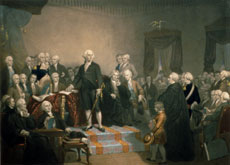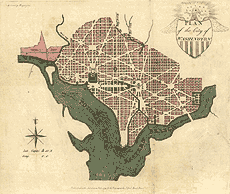 |

The Presidential Years
|
 |


THE PRESIDENTIAL YEARS
 |
 |

George Washington
Addressing Congress
The Mount Vernon
Ladies’ Association
|
 |
After ratification by the ninth state, a federal government is born. Electors from every state unanimously chose Washington to be the first President.
In a letter to a friend he writes: “In confidence I can assure you—with the world, it would obtain little credit—that my movements to the chair of Government will be accompanied by feelings not unlike those of a culprit who is going to his place of execution.”
|
 |
Congress moves the capital from New York to Philadelphia for ten years. After that, the federal government is to move to a permanent site on the Potomac River selected by Washington, who is trusted by both North and South.
|
 |
Washington proclaims that the new capital will be along the Potomac, from Georgetown, MD, to the north and Alexandria, VA, to the south. A Maryland newspaper promptly calls the proposed capital “The City of Washington.”
Washington commissions a French engineer, Major Pierre L'Enfant, to design the city.
|
 |
 |

Plan for the city of Washington, 1793
Library of Congress
|
 |
Washington is unanimously reelected to a second term.
|
 |
Washington marshals an armed Federal force to put down the Whiskey Rebellion—a revolt, centered in Pennsylvania, against a tax on a major state export. He sees his action as a key test of the executive branch’s right to back federal laws with force.
“If the laws are to be trampled upon with impunity,” he writes, “and a minority (a small one too) is to dictate to the majority, there is an end put, at one stroke, to republican government.”
|
 |
Washington, in a rare political battle, fights successfully for Senate ratification of Jay’s Treaty, which is aimed at settling post-Revolution issues between America and England and asserting U.S. neutrality in conflict between England and revolutionary France.
|
 |
Washington, who declined a third term, writes his Farewell Address, urging his fellow citizens—“Northern and Southern, Atlantic and Western”—to “properly estimate the immense value of your national Union.”
|
 |
After less than three years of retirement in his beloved Mount Vernon, Washington dies there on December 14 of a throat infection. His last words are “’Tis well.” In his will, he frees his slaves, numbering about 300, upon Martha’s death.
|
|




